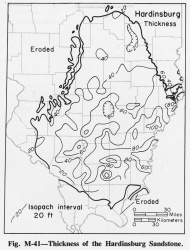Hardinsburg Sandstone
Lithostratigraphy: Pope Megagroup >>Okaw Group >>Hardinsburg Sandstone
Chronostratigraphy: Paleozoic Erathem >>Mississippian Subsystem >>Chesterian Series >>Hombergian Stage
Allostratigraphy: Kaskaskia Sequence
Primary source
Willman, H. B., Elwood Atherton, T. C. Buschbach, Charles Collinson, John C. Frye, M. E. Hopkins, Jerry A. Lineback, and Jack A. Simon, 1975, Handbook of Illinois Stratigraphy: Illinois State Geological Survey Bulletin 95, 261 p.
Contributing author(s)
Elwood Atherton, Charles Collinson, and Jerry A. Lineback
Name
Original description
Hardinsburg Sandstone (Brokaw, 1916, pl. 3; Butts, 1917, p. 23).
Derivation
Named for Hardinsburg, Breckenridge County, Kentucky.
Other names
History/background
Type section
Type location
The type section of the Hardinsburg Sandstone is near the town of Hardinsburg, Breckenridge County, Kentucky.
Type author(s)
Type status
Reference section
Reference location
Reference author(s)
Reference status
Stratigraphic relationships
Extent and thickness
The Hardinsburg is 30 feet thick in the type section. It is a clastic unit commonly 50-100 feet thick but thinner to the north and west (fig. M-41). In Lawrence County, the Hardinsburg locally cuts entirely through the underlying Golconda Group and into the uppermost part of the Cypress Sandstone to attain a thickness of more than 240 feet.
Lithology
The formation has a thick-bedded sandstone facies and a thin-bedded, flaggy, shaly sandstone and shale facies, both exposed in the southern outcrop belt. Well developed sandstone bodies lens in and out of the section within fairly short distances at various horizons and locally make up almost the entire formation. The sandstone in the Hardinsburg is largely light gray, very fine grained, friable, and in part calcareous. The thick sandstone bodies are white and fine grained, whereas the thin bodies are generally gray or green and compact, some of them grading to siltstone. The sandstone bodies show a complex deltaic pattern with braids, tributaries, and distributaries (Potter, 1963). Much of the system is to the east in Indiana and Kentucky, but bifurcating arms extend into Illinois. Thin beds of coal occur locally in the upper part of the sandstone. The shale in the Hardinsburg is mainly dark gray or dark greenish gray. At the base of the Hardinsburg, red, green, and dark gray shale as much as 30 feet thick contains beds and nodules of lithographic, red and brown limestone and dolomite. In most places an erosional surface separates the shale from the upper part of the Hardinsburg, and in some places the surface cuts entirely through the shale, so that sandstone rests directly on the underlying Golconda Croup.
Core(s)
Photograph(s)
Contacts
Well log characteristics
Fossils
Age and correlation
Environments of deposition
Economic importance
Remarks
References
BROKAW, A. D., 1916, Preliminary oil report on southern Illinois: Illinois State Geological Survey Extract Bulletin 35, 13 p.
BUTTS, CHARLES, 1917, Descriptions and correlations of the Mississippian formations of western Kentucky, Part I of Mississippian formations of western Kentucky: Kentucky Geological Survey, v. 1, 119 p.
POTTER, P. E., 1963, Late Paleozoic sandstones of the Illinois Basin: Illinois State Geological Survey Report of Investigations 217, 92 p.
ISGS Codes
| Stratigraphic Code | Geo Unit Designation |
|---|---|
